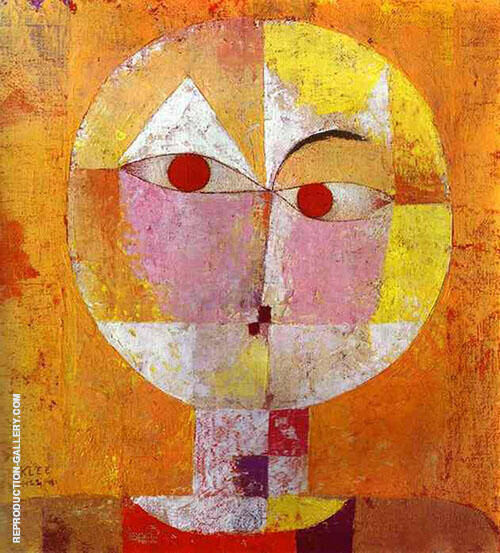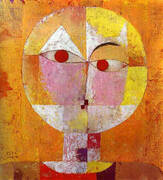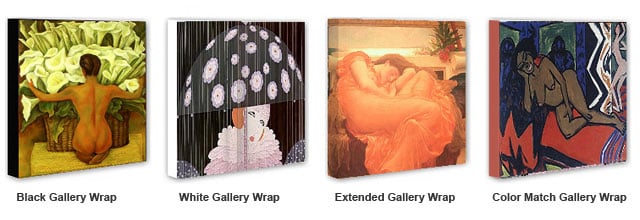Senecio 1922 By Paul Klee
Senecio by Paul Klee
Painted in 1922, Senecio by Paul Klee is a fascinating example of Cubism and Expressionist art. Measuring just 40 by 38 centimeters, it is a colorful painting and an example of abstract Paul Klee paintings. Nonetheless, it creates an extreme emotional connection and is one of our popular reproductions of the Cubism art style. Paul Klee Cat and Bird painting of 1928 bears a striking likeness to Senecio.
What is the Meaning of this Paul Klee Artwork?
Sometimes referred to as Head of a Man Going Senile, the painting represents a round face split up into squares of color. The eyes gaze inquiringly with one eyebrow raised while the figure appears to slowly morph into or arise from the bright orange and yellow background. As the name suggests, the painting references themes of aging and senility. The flat geometric, brightly colored squares could reference a mask or the patches on a harlequin’s outfit. Linking to the fears we all have about growing older and losing our mental capacities and vigor, it’s a fascinating portrait. Indeed, the painting's title draws out the connections between mask-wearing and aging. Senecio means 'Old Man' in Latin and was also a well-known performer. The figure’s raised eyebrow suggests although the mask of senility is creeping in, the man’s intelligence and individuality still shine through. The simplicity of form is evident in Paul Klee's painting and touches on his interest in African tribal masks. This is referenced in other oil paintings such as Exuberance and Death and Fire.
Why did Paul Klee Paint Senecio?
Paul Klee never wrote explicitly about his reasons for creating his famous painting. However, it is particularly notable for its cubist influence. As a 20th century avant-garde art movement, Cubism focuses on analyzing and breaking up objects and people into abstract forms. While Senecio maintains a single viewpoint, Paul Klee presents several divides and cross-sections within the oil painting. These unusual dividing lines encourage viewers to assess the older man from numerous intellectual and visual perspectives. On the one hand, the portrait presents a humorous, wry figure full of inner life. From another perspective, the older man’s round face takes on an innocent, childlike form. Paul Klee artwork also intensely investigates color theory. The use of color particularly fascinated the artist, who wrote and lectured on the topic throughout his career.
Similar orange and red tones are evident in another Paul Klee artwork, painted just six years after Senecio. Paul Klee Castle and Sun 1928 also utilizes simple triangles, squares, and circles to depict an abstract artwork of a city scene. The work’s joyfulness and brightness make it one of the most often reproduced Paul Klee replica paintings.
What Medium is Senecio?
Senecio is an oil on canvas painting. Amongst paintings of abstract faces, it’s particularly expressive. Indeed, Paul Klee’s expert use of lines and ambiguous shapes demonstrates his skill in creating compositions from simple graphic elements. He once claimed these elements were set in motion by the artist’s mind. While the paint initially appears haphazardly scraped onto the canvas, Klee carefully planned every detail of his color and lines. The geometric methods used in Senecio make it exceptionally well-respected among artists today.
Where is Paul Klee Senecio?
The painting currently hangs in the Kunstmuseum. Based in Basel, Switzerland, this museum boasts the oldest public art collection in the entire world. It’s famed as the most important museum in Switzerland, with heritage extending back to a Hans Holbein purchase in 1661. As well as famous Renaissance oil paintings, the museum holds many artworks from the Dutch Golden Age, including paintings by Peter Paul Rubens and Rembrandt van Rijn. In addition to famous 19th century impressionist paintings, the Museum’s collection mainly focuses on Cubism oil paintings. In addition to a unique collection of paintings by Paul Klee, the museum holds artwork by Picasso, Georges Braque, and Juan Gris. Oil painting reproductions of famous paintings by Paul Klee are included in our large selection of 20th Century replica art.
We offer a 100% money back guarantee or replacement service. If for any reason you are dissatisfied with your painting please contact us within 7 days of receipt, advising the reason you are unhappy and we will provide you with all the information you need for its return or replacement.
We ship free to anywhere in the world via FedEx or DHL expedited service with online tracking.
Your painting will be shipped rolled in strong plastic tubing, ready for stretching and/or framing locally. This is the conventional method of transporting hand-painted oil on canvas. Learn more about how your painting is shipped.
We are able to offer a framing service intercontinental U.S. Please contact us if you would like a quotation. Alternatively, should you prefer, we can recommend a framer in your area.
Notes About Your Painting
Please note that replica oil paintings are finished with an additional 10cm (4") of extra canvas on all sides, allowing ample surplus canvas for stretching and framing.
Recently Viewed:
Cannot Find What You Are Looking For?
Reproduction Gallery Information
Customer Service
(Send Us A Message)
Tel: (503) 937 2010
Fax: (503) 937 2011







